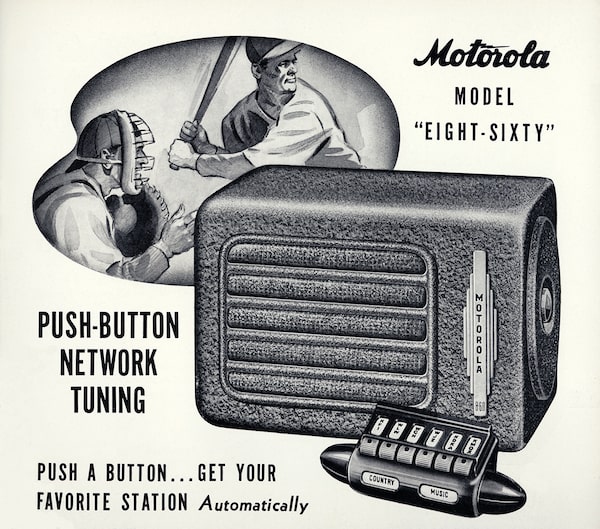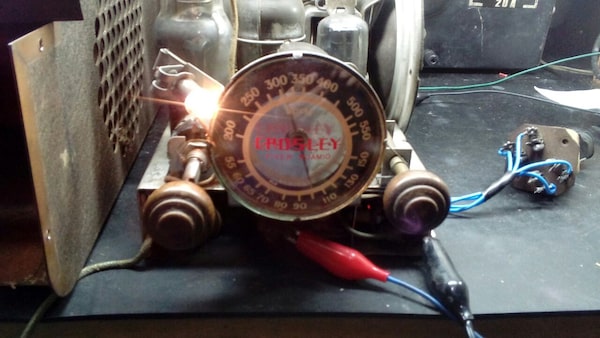
A flyer for a push-button Motorola car radio, a common option on cars starting in the late 1930s.Handout
“Hey, Google. Play Toosie Slide by Drake.”
Within seconds, the Toronto pop singer’s silky voice wafts from the speakers of the ELS Studio audio system of my Acura MDX. Ten speakers in the cabin pump out trilling highs and chest-thumping bass, transforming my vehicle into a soothing audio studio on wheels. Bored, I flip over to SiriusXM for a little Hip-Hop Nation.
Modern car audio systems are so highly evolved, so seamless and so intuitive, it’s easy to forget that it wasn’t always this way. But it’s been 90 years since the first mass-produced car radio appeared, and the road to audio perfection has been a bumpy one indeed.
Michael Lamm remembers. At 84, the California-based auto historian’s car-ownership experience spans back to the early 1950s, when staticky car radios were powered by primitive vacuum tubes.
When he was growing up in Texas, he says he “didn’t really care that much about radio,” in part because programming was so limited. “I didn’t listen to the preachers who were constantly haranguing everybody.”
Radio enthusiast Brian Belanger remembers the local programming in the small northern Minnesota town where he spent his teens in the 1950s. While his friends were listening to rock ‘n' roll, he preferred the twang of country stars like Ernest Tubb and Patsy Cline. His home radio station broadcast local football games, polka music and the weekly Swap Shop, where listeners bought and sold used goods.

A functional radio from a 1937 Crosley, seen at the Henry Ford Museum.Henry Ford museum/Handout
Belanger, 79, said car radios didn’t really become common until the 1950s.
“The first car my dad bought with a car radio was a 1955 Buick,” says Belanger. “I thought that was the greatest thing.”
Belanger is volunteer caretaker of the National Capital Radio and Television Museum, a donor-funded institution in Bowie, Md. It has “several thousand” artifacts, but only enough room to display about 10 per cent of the collection at a time.
Today there are literally thousands of audio options available over the air, through satellite, by podcast or through your own custom playlist. Yet those imperfect car radios remain as much a source of fascination as the antique automobiles in which they were mounted.
So let’s follow the long and winding road to audio perfection.
Before the dawn of audio
Before audio, there was the car telegraph. In 1901, Guglielmo Marconi installed a telegraph in a Thornycroft steam-powered wagon. It received and transcribed Morse Code telegraph messages. Radio receivers didn’t become viable until about 1920 as vacuum-tube technology progressed. Initially, people would bring heavy portable radios in their cars, complete with separate batteries, and set up elaborate antennas. Because electrical interference from the engine caused static, the radios could only be used when the car was turned off.
The first commercial car radio
Some historians argue that the first car radio was installed by Kelley’s Motors in New South Wales, Australia, in 1924.
Lamm says the first entrepreneur to go into radios commercially was William Heina, who founded Heinaphone Corp. around 1926, which later became Philco and was eventually acquired by Philips.

A Collin B. Kennedy radio receiver installed on a Pierce-Arrow in 1924.Henry Ford museum/Handout
But it was the precursor to Motorola – Galvin Manufacturing Corp. – that introduced the first mass-market car radio in June, 1930. It didn’t have a brand name at first, says Steven O’Bannon, Texas-based principal staff engineer for Motorola.
Brothers Paul and Joseph Galvin’s first radio ran on six vacuum tubes, took up about 10 litres of cargo space, received AM signals only, was housed in a wooden case and was powered by two high-voltage batteries stashed under the passenger seat, plus the car’s battery. It cost US$130 at a time when an entire Ford Model A cost US$540.
To cut down on static, spark plugs were fitted with a “suppressor” that actually downgraded the performance of the engine.
“It was a fine balance between getting reception and having the car work at all,” O’Bannon said.
Paul Galvin, realizing the radio needed a brand, created a portmanteau of “motor car” and the suffix “ola” (slang for anything audio) and came up with Motorola.
Innovations come quickly

A circa-1930 brochure advertises a Motorola car radio.Handout
Galvin introduced a series of innovations to its Motorola radios. By the early to mid-1930s, there was no need for spark-plug suppressors, radios could run on the car’s battery alone and volume was automatically adjusted for the broadcast strength of a radio transmitter. Motorola introduced the first dash-mounted radios in the mid-1930s.
By the late 1930s, push-button AM radios were a common option for cars.
FM makes its debut
AM radio was plagued by static interference and poor sound quality, so FM prototypes were being tested by the late 1930s. Blaupunkt, a German company, produced the first FM radio for cars in 1952. Within a year, Becker Audiosound produced a combined AM/FM radio. Programming often amounted to just a few hours a day, typically classical music, Lamm says.

FM radios first appeared in the 1950s.Handout
“It wasn’t until FM that I got interested in car radio because I liked classical music,” he said. “That’s what turned it for me.”
FM grew steadily until its total North American audience finally surpassed that of AM radio in 1979.
Transistors arrive in ’55
Radios were powered by hot, bulky and fragile vacuum tubes that needed to warm up before the radio would come on. Belanger said road vibrations would cause them to fail frequently. To get the radios out for service, you’d have to reach up under the dash to undo the screws.
“It was a pain in the neck,” he says.
By 1955, Chrysler offered an all-transistor Mopar radio as a US$150 option on its 1956 Chrysler and Imperial cars. That’s the equivalent of about US$1,500 today, so the uptake was limited. After Chrysler’s experience, automakers reverted to hybrid radios with a mix of transistors and vacuum tubes.
Full transistor radios did not appear again until the early 1960s, when Becker unveiled a solid state radio with no vacuum tubes. Although radios were an option, by 1963, 50 million cars in the United States – more than 60 per cent – had them.
Recorded music goes mobile
Chrysler brought recorded music to cars with the first in-car phonograph in 1956. The so-called Highway Hi-Fi came with a mini turntable mounted under the passenger side dash. It was ridiculous, skipping tracks at every bump.
Yet researchers were undeterred. Engineer Earl (Madman) Muntz transformed the mobile music world when he unveiled four-track audio tape-cartridge technology in the early 1960s. Ford and Motorola jointly introduced the eight-track tape player as optional equipment for 1966 Ford car models, and the design dominated car audio throughout the 1970s. The devices were notorious for fading out mid-song while they switched to the next stereo track and also for eating tapes. But they were simple to operate and relatively cheap.
Cassettes become the medium of choice
Even as the eight-track was enjoying its heyday, Philips unveiled the first compact cassette in 1964. Initially, the sound was muddy, but tape quality steadily improved until 1979, when Sony introduced the first Walkman, bringing portable recorded music to the masses. Cassettes allowed individuals to create their own playlists, and they proved to be hugely popular throughout the 1980s.
CDs herald the digital era
CDs began to appear with Pioneer’s CDX-1 in 1984. CDs offered better sound quality, instant track skipping and improved durability over cassette tapes. Most were offered as aftermarket add-ons, but the 1987 Lincoln Town Car become the first vehicle to offer CD players out of the factory.
iPods trigger the multi-source era
The arrival of the iPod in 2001 made it possible to plug your digital music into your car’s audio system through the auxiliary outlet. Eventually, smartphones came with full-service audio players.
Today’s drivers connect their devices to their cars through USB, Bluetooth or auxiliary cord. Now Apple’s CarPlay and Google’s Android Auto allow drivers hands-free access to their audio files and to streaming services, such as Spotify and Pandora. Meanwhile, SiriusXM offers dozens of dedicated channels, including music, talk news and sports.
“Today, people buy various cars just for their sound systems,” marvels Lamm. And today’s infotainment systems seamlessly blend our need for information and communication with the ability to listen to whatever we want.
New frontiers in auto sound
Sound systems are now being used to enhance the driving experience itself.
Noise-cancellation systems emit sounds that can neutralize road noise, tire noise and chassis vibrations.
On the flip side, automakers such as Ford, Volkswagen and BMW are using audio systems to artificially enhance the sound of their engines, creating a sportier feel for the driver.
What’s next? “I have a hard time imagining,” says Motorola’s O’Bannon. He says it appears the technology has hit a plateau, and it may be a few years before further innovations appear.
Don’t be so sure, says Belanger, of the National Capital Radio and Television museum. He noted that Charles Duell, commissioner of U.S. patent office, once declared, “Everything that can be invented has been invented.” The year was 1899.
Shopping for a new car? Check out the new Globe Drive Build and Price Tool to see the latest discounts, rebates and rates on new cars, trucks and SUVs. Click here to get your price.
Stay on top of all our Drive stories. We have a Drive newsletter covering car reviews, innovative new cars and the ups and downs of everyday driving. Sign up for theweekly Drive newsletter, delivered to your inbox for free. Follow us on Instagram,@globedrive.